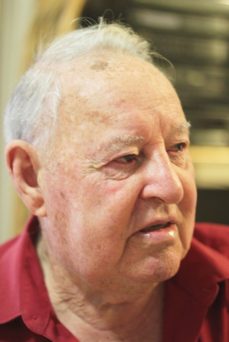E01 How Times Change
Produced by David Ward on June 28, 2017
Tags - Buchfelde - Elder - Graham Tucker - Interviewed by Maureen McKenzie - James Martin - John McKinlay - Martindale - My Bors - Oaklands Estate - Smith & Co - The 49ers - Timer Fashions

Graham Tucker is virtually a walking encyclopaedia of knowledge when it comes to the history of Gawler, and in our very first ever Gawler Oral History Project interview we’re lucky enough to have Graham take us on a tour or his life and our town.
Whether you find him at the Gawler Visitor Information Centre, or the National TrustMuseum on Murray St, or giving historic tours during history month each May, Graham is always able to tell us something new and interesting we never knew about our town’s history.
In conversation with the GOHP’s Maureen McKenzie, Graham talks about some of the changes he’s seen occurring over the years he has lived and worked in Gawler, and tells us some stories about out town’s history, including how a group of escaped revolutionary German scientists came to settle at Buchfelde and be know as the 49ers, how Murray St used to be just as full of bullock traffic as it is full of cars today, and how a tiny settlement called Gawler came to dominate the foundry industry in the 1800’s.

Graham Tucker at History Month 2016
For years Graham has been giving tours during History Month, revealing his deep knowledge of the history of Gawler and the surrounding areas.
(Image courtesy of GBA)
Elder, Smith & Co, Minlaton Branch
Graham sold industrial and farm equipment for Elder, Smith & Co at branches all around the state.
(Image courtesy of the State Library of South Australia: SLSA B73722/2)
(Moritz) Richard Schomburgk
Richard was the brother of Otto Schomburgk, who founded Buchfelde in 1849 after escaping political persecution in Germany. Richard went on to become the second curator of the Adelaide Botanic Gardens.
(Image courtesy of wikipedia commons)
Oaklands Estate
Originally built for the Pile Family (pictured in front of the house), but in 1863 John McKinlay and Miss Jane Pile were married. After his search for Burke & Wills, and his expedition to explore the Northern Territory, McKinlay and his family took up residence at Oaklands Estate.
(Image courtesy of the Gawler History Team)
John McKinlay
This image of “Big” John McKinlay is a photograph of the portrait which has hung for many years in the Reading Room at the old Gawler Library.
(Image courtesy of the Gawler History Team)
The Old Spot Hotel (circa 1840s)
The Old Spot Hotel was one of the first buildings in Gawler, and because the bullock trains would stop there, the town’s centre began to move from Cowan St, where it was planned, to focus around Murray St.
(Image courtesy of the Gawler History Team)
The James Martin Foundry
This photo of the James Martin Foundry on the corner of Murray St and Calton Rd was taken some time after 1903. In the late 19th and early 20th centuries there were 4 foundries and all sorts of industries operating out of Gawler.
(Image courtesy of the Gawler History Team)
Inside the James Martin Foundry
At one stage, there was nearly 1000 workers in and around Gawler working in the foundries about town, producing farm equipment, tools, trains and so much more.
(Image courtesy of the Gawler History Team)
Martindale Hall
Originally built as his family’s home, Martindale Hall afforded James Martin a continuous view of his foundry, located just down the hill from this impressive early residence.
(Image courtesy of the Gawler History Team)
May Bros & Co
Established in 1885 on land at Eighteenth St, this small family business building farm equipment became a huge manufacturing plant growing to over 300 employees, providing heavy industrial equipment to the mining industry
(Image courtesy of the Gawler History Team)
Alfred May
Frederick and Alfred May built one of the largest manufacturing businesses in 19th century Gawler. After his brother’s death in 1897, Alfred kept the business going until 1924.
(Image courtesy of the Gawler History Team)
Frederick May
Frederick and his brother Alfred turned their small family foundry into one of the biggest industrial concerns in the town. Frederick died in 1897, but his brother Alfred continued the business until 1924.
(Image courtesy of the Gawler History Team)
Timer Fashions
Operating from 1942 to 1978, Timer Fashions produced clothes for all ages. Manufacturing at their Julian Terrace factory, hundreds of people who lived in Gawler worked at Timer fashions over the years.
(Image courtesy of Gawler History Team)
Inside Timer Fashions
From their factory on Julian Tce, Timer Fashions produced thousands of garments over their 35 years in the trade, before finally closing their doors in 1978.
(Image courtesy of the Gawler History Team)
Trevu House
With its views extending east, west and south, James Martin’s Trevu House sits on the hills east of the main street and overlooking the river.
(Image courtesy of the Gawler History Team)
You won’t find many people more enthusiastic – or knowledgeable – about Gawler’s history than Graham Tucker. We’re hoping to talk more with Graham in the future, and hear more of his tales of our history, but now, we’re really happy that Graham has shared his stories with us – in the very first ever Gawler Oral History Project Interview!
Production Notes
Title: E01: How times change
Guest: Graham Tucker
Host: Maureen McKenzie
Producer: Barry Neylon
Editor: Ian McDonnell
Transcript: Maureen McKenzie
GOHP E01 – Graham Tucker by The Gawler Oral History Project is licensed under a Creative Commons Attribution-NonCommercial 4.0 International License.
Want to find out more about Graham Tucker? Head over to the Gawler History Team and check out their collection of stories and photos of Gawler throughout the years.

